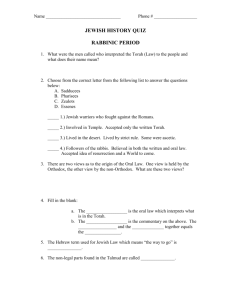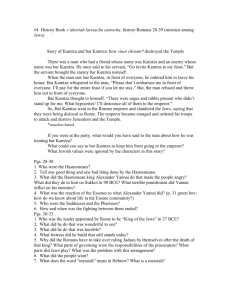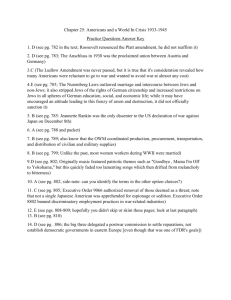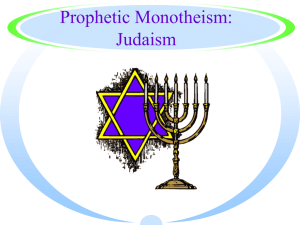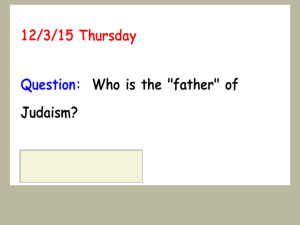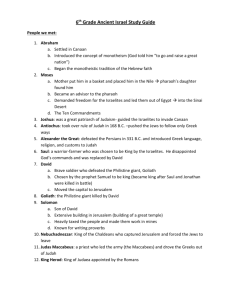Reading Strategy - UC Berkeley History
advertisement
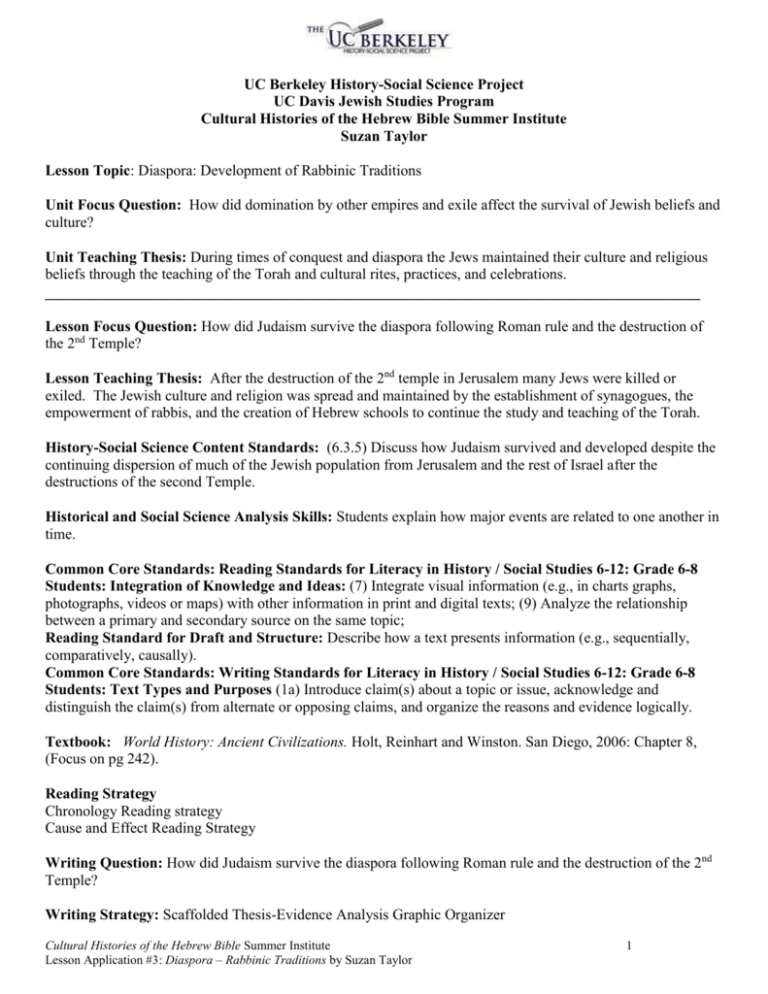
UC Berkeley History-Social Science Project UC Davis Jewish Studies Program Cultural Histories of the Hebrew Bible Summer Institute Suzan Taylor Lesson Topic: Diaspora: Development of Rabbinic Traditions Unit Focus Question: How did domination by other empires and exile affect the survival of Jewish beliefs and culture? Unit Teaching Thesis: During times of conquest and diaspora the Jews maintained their culture and religious beliefs through the teaching of the Torah and cultural rites, practices, and celebrations. _______________________________________________________________________________________ Lesson Focus Question: How did Judaism survive the diaspora following Roman rule and the destruction of the 2nd Temple? Lesson Teaching Thesis: After the destruction of the 2nd temple in Jerusalem many Jews were killed or exiled. The Jewish culture and religion was spread and maintained by the establishment of synagogues, the empowerment of rabbis, and the creation of Hebrew schools to continue the study and teaching of the Torah. History-Social Science Content Standards: (6.3.5) Discuss how Judaism survived and developed despite the continuing dispersion of much of the Jewish population from Jerusalem and the rest of Israel after the destructions of the second Temple. Historical and Social Science Analysis Skills: Students explain how major events are related to one another in time. Common Core Standards: Reading Standards for Literacy in History / Social Studies 6-12: Grade 6-8 Students: Integration of Knowledge and Ideas: (7) Integrate visual information (e.g., in charts graphs, photographs, videos or maps) with other information in print and digital texts; (9) Analyze the relationship between a primary and secondary source on the same topic; Reading Standard for Draft and Structure: Describe how a text presents information (e.g., sequentially, comparatively, causally). Common Core Standards: Writing Standards for Literacy in History / Social Studies 6-12: Grade 6-8 Students: Text Types and Purposes (1a) Introduce claim(s) about a topic or issue, acknowledge and distinguish the claim(s) from alternate or opposing claims, and organize the reasons and evidence logically. Textbook: World History: Ancient Civilizations. Holt, Reinhart and Winston. San Diego, 2006: Chapter 8, (Focus on pg 242). Reading Strategy Chronology Reading strategy Cause and Effect Reading Strategy Writing Question: How did Judaism survive the diaspora following Roman rule and the destruction of the 2nd Temple? Writing Strategy: Scaffolded Thesis-Evidence Analysis Graphic Organizer Cultural Histories of the Hebrew Bible Summer Institute Lesson Application #3: Diaspora – Rabbinic Traditions by Suzan Taylor 1 Procedure: Activity 1: Chronology Reading Strategy Students read “The Rise and Fall of the Hebrew Kingdoms” (McDougal Littell, p. 341) and complete graphic organizer. Activity 2: Timeline and Map Activity Using the graphic organizer, students complete a timeline of ancient Hebrew history. Students need a blank timeline chart on 11x17 paper, and a copy of the maps. Students will include illustrations or symbols that represent each event. Scissors and glue stick needed. Activity 3: Cause and Effect Reading Strategy Students read “Results of the Revolt” (Holt, p. 242) and fill out the cause and effect chart. Activity 4: Writing Strategy Students will use the extended paragraph graphic organizer (with a thesis provided) to develop the evidence and analysis needed to write an extended paragraph. Activity 5: Writing Prompt Using the information on the extended paragraph graphic organizer, students will compose an extended paragraph that includes a thesis, relevant and accurate evidence, analysis, and a concluding sentence. Cultural Histories of the Hebrew Bible Summer Institute Lesson Application #3: Diaspora – Rabbinic Traditions by Suzan Taylor 2 Activity 1: Chronology Reading Strategy The Rise and Fall of the Hebrew Kingdoms Directions: Read the passage below and circle the dates then underline the events that relate to that date. The first king of Israel was Saul. He became king in 1020 B.C. His successor, King David, expanded the kingdom. He established a dynasty that lasted for about 400 years. The kingdom of Israel reached its peak during the reign of David’s son Solomon. He took the throne in 962 B.C. and reigned for 40 years. His greatest achievement was the construction of a great Temple in Jerusalem. After Solomon’s death, the kingdom split in two. The northern kingdom was called Israel, and the southern kingdom was called Judah. The kingdom was not as strong after the split. In 722 B.C., Assyria took over Israel but not Judah. Then in 586 B.C., the Babylonians conquered Judah. Thousands were taken to Babylon as slaves. The Jews remained slaves in Babylon until 538 B.C. At that time, Cyrus the Great of Persia conquered the Babylonians. He freed the Jews and allowed them to return to Palestine. After their return, the Jews rebuilt the Temple of Jerusalem. It was completed in 515 B.C. In 198 B.C., the Seleucid Kingdom of Syria seized control of Judah. Syrians introduced Greek religion and culture. The first rulers allowed the Jewish people to continue to observe and practice their religion. In 175 B.C., a new Syrian ruler made it a crime to observe Jewish laws or study the Torah. The Jews rebelled and fought Syria. A Jews priest along with his five sons, the Maccabeus, led the revolt. By 164 B.C. the Jews had regained control of Jerusalem. The independence of the Jews did not last. After less than a century of self-rule, another foreign power took control. In 63 B.C., the Romans conquered Judah. Rome allowed the Jews to have Jewish kings and religious leaders, but they had to be appointed by Rome. A revolt was led by a Jewish group called the Zealots in A.D. 66. Roman troops, under the Titus, put down the rebellion in A.D. 70, burning the second Temple and taking Jerusalem. The destruction of Jerusalem and the Temple by the Romans caused most Jews to flee. This is known as the Diaspora, or the scattering of the Jews. Jews settled throughout the Roman Empire while many Jews were sent to Rome as slaves. Adapted from Ancient Civilizations, McDougal Littell, 2006. Pages 341-342. Cultural Histories of the Hebrew Bible Summer Institute Lesson Application #3: Diaspora – Rabbinic Traditions by Suzan Taylor 3 Activity 1: Chronology Reading Strategy Student Chart NAME: ____________________________ Use the text passage on page 4 to create a timeline that represents the rise and fall of the Hebrew Kingdom. Significance to Survival of Jews/ Time marker Events Questions About 2000 B.C. Abraham leaves Mesopotamia Receives Covenant-beginning of religious belief on one God 1200 B.C. Israelites leave Egypt Hebrews settle in Canaan- remembered by/Passover celebration . . Cultural Histories of the Hebrew Bible Summer Institute Lesson Application #3: Diaspora – Rabbinic Traditions by Suzan Taylor 4 Activity 2: Timeline Activity 1. On 11x17 paper students create a timeline from the chart on page 5. 2. Include illustrations or symbols that represent each event. 3. Cut out the maps on pages 6-8 and glue them to the corresponding dates. Cultural Histories of the Hebrew Bible Summer Institute Lesson Application #3: Diaspora – Rabbinic Traditions by Suzan Taylor 5 Cut out maps Cultural Histories of the Hebrew Bible Summer Institute Lesson Application #3: Diaspora – Rabbinic Traditions by Suzan Taylor 6 Cut out maps Cultural Histories of the Hebrew Bible Summer Institute Lesson Application #3: Diaspora – Rabbinic Traditions by Suzan Taylor 7 Cut out maps Cultural Histories of the Hebrew Bible Summer Institute Lesson Application #3: Diaspora – Rabbinic Traditions by Suzan Taylor 8 Activity 3: Cause and Effect Reading Strategy The Hebrews and Judaism- Results of the Revolt Read the following passage. In the boxed section, underline the different effects, short and long term, that the destruction of the 2nd temple had on the Hebrew culture and/or religion. Ex: thousands of Jews left Jerusalem. With the capture of Masada [the Jewish mountain fortress] in AD 73, the Jewish revolt was over. As punishment for the Jews’ rebellion, the Romans killed much of Jerusalem’s population. They took many of the surviving Jews to Rome as slaves. The Romans dissolved the Jewish power structure and took over the city. Many were taken as slaves, and thousands of Jews left Jerusalem after the destruction of the Second Temple. With the Temple destroyed, they didn’t want to live in Jerusalem anymore. Many moved to Jewish communities in other parts of the Roman Empire. One common destination was Alexandria in Egypt, which had a large Jewish community. The population of these Jewish communities grew after the Romans destroyed Jerusalem. Second Revolt Some Jews, however, chose not to leave Jerusalem when the Romans conquered it. Some 60 years after the capture of Masada, these Jews, unhappy with Roman rule began another revolt. Once again, however, the Roman army defeated the Jews. After this rebellion in the 130s the Romans banned all Jews from the city of Jerusalem. Roman officials declared that any Jew caught in or near the city would be killed. As a result, Jewish migration throughout the Mediterranean region increased. Migration and Discrimination For those Jews not living in Jerusalem, the nature of Judaism changed. It was because the Jews no longer had a single temple at which to worship, local synagogues became more important. At the same time, leaders called rabbis or religious teachers took on a greater role in guiding Jews in their religious lives. Rabbis were responsible for interpreting the Torah and teaching. This change was largely due to the actions of Yohanan ben Zaccai, a rabbi who founded a school at Yavneh, near Jerusalem. In this school, he taught people about Judaism and trained them to be rabbis. These schools became an important part of every community and preserved the Jewish culture and religion. Influenced by Yohanan, rabbis’ ideas shaped how Judaism was practiced for the next several centuries. Many rabbis also served as leaders of Jewish communities. Over many centuries, Jews moved out of the Mediterranean region to other parts of the world. In many cases this movement was not voluntary. The Jews were forced to move by other religious groups who discriminated against them. This discrimination forced many Jews to leave their cities and find new places to live. As a result, some Jews settled in Asia, Russia and much later, the United States. World History: Ancient Civilizations, Holt Rinehart and Winston, 2006: page 242 Cultural Histories of the Hebrew Bible Summer Institute Lesson Application #3: Diaspora – Rabbinic Traditions by Suzan Taylor 9 Student Chart NAME: ____________________________ The Hebrews and Judaism- Results of the Revolt Cause & Effect Reading Strategy Cause and Effect/ Impact- fill out the chart below. On the right side of the chart, you will write the actions that the Hebrews took after the destruction of their 2nd temple that you think contributed to the survival and growth of their religion. Cause Effect Cultural Histories of the Hebrew Bible Summer Institute Lesson Application #3: Diaspora – Rabbinic Traditions by Suzan Taylor Impact on the Hebrew Religion 10 Activity 4: Extended Paragraph Graphic Organizer NAME: ____________________________ Background: After the Romans destroyed the Hebrew temple in AD 70, many Hebrews fled Jerusalem. This diaspora led to the Jews spreading throughout the Roman Empire. Writing Question: How did Judaism survive the diaspora following Roman rule and the destruction of the 2nd Temple? Thesis (topic sentence): After the destruction of the 2nd Temple by the Romans, the Jews continued their religion by building synagogues, empowering rabbis, and creating schools to study the Torah. Topic Topic #1: Topic #2: Topic #3: Evidence Rabbis’ role Rabbis or religious leaders, took a great role in guiding Jews Specific Evidence Rabbis were responsible for interpreting the Torah and the will of G-d Analysis The rabbis were seen as leaders to the Jews. The Jews looked to the rabbis as community leaders. The rabbis were able to spread and shape their beliefs to more people. Cultural Histories of the Hebrew Bible Summer Institute Lesson Application #3: Diaspora – Rabbinic Traditions by Suzan Taylor 11 Activity 5: Writing Prompt Diaspora after the Destruction of the 2nd Temple Background: After the Romans destroyed the Jewish temple in AD 70, many Jews fled Jerusalem. This diaspora led to the Jews spreading throughout the Roman Empire. Writing Question: How did Judaism survive the diaspora following Roman rule and the destruction of the 2nd Temple? Writing Expectations: Write a well-developed paragraph that fully answers the focus question. The paragraph must include the following: A clearly stated thesis Three pieces of evidence to support your thesis- need to be historically accurate Analysis that connects and explains how the evidence proves the thesis Accurate and relevant vocabulary Complete sentences Correct spelling, punctuation, and grammar Map of the Roman empire at the death of Augustus in AD 14. The shaded areas represent the main areas of Jewish settlement at the time. (From Antony Kamm, The Israelites: an Introduction, Routledge 1999). http://www.the-romans.co.uk/cults.htm Cultural Histories of the Hebrew Bible Summer Institute Lesson Application #3: Diaspora – Rabbinic Traditions by Suzan Taylor 12 Activity 1: Chronology Reading Strategy Student Chart –KEY Use the text passage on page 4 to create a timeline that represents the rise and fall of the Hebrew Kingdom. Time marker Events About 2000 B.C. Abraham leaves Mesopotamia 1200 B.C. Israelites leave Egypt 1020 B.C. King Saul/David 962 B.C. King Solomon 722 B.C. Assyria conquers Israel 587 B.C. Babylonians conquer Judah 538 B.C. Persia –Cyrus the Great 515 B.C. Persian Occupation 198 B.C. Seleucid Kingdom of Syria seize Judah 175 B.C. Syrian Control 164 B.C. Maccabee revolt Greek Influence – at first could still practice religion Map Illegal to practice Jewish religion and studies Regain Jerusalem/Hanukkah 63 B.C. Romans conquer Judah Map- Roman rule 66 A.D. Zealots rebel against Roman rule Jews resist 70 A.D. Titus puts down rebellion 2nd Temple Destroyed/Diaspora throughout Roman Empire map Cultural Histories of the Hebrew Bible Summer Institute Lesson Application #3: Diaspora – Rabbinic Traditions by Suzan Taylor Significance to Jewish religion and culture/Questions Receives Covenant-beginning of religious belief on one God Map Settle in Canaan- Observed in Passover Celebration Empire Map Begins 400 year dynasty Map Temple of Jerusalem- after death splits into 2 kingdoms Judah remains only Jewish Kingdom Map Temple destroyed and Jews exiled to Babylon Map Allows Jews back to Judah to rebuild society Map Temple rebuilt and completed 13 Activity 2: Timeline Activity –KEY 1. On 11x17 paper students create a timeline from the chart on page 5. 2. Include illustrations or symbols that represent each event. 3. Cut the maps on pages 6-8 and glue them to the corresponding dates. c. 722 B.C. Map of the Assyrian Empire c. 1200 B.C. The exodus c. 2000 B.C. Map of Mesopotamia with Abraham’s journey c. 1020 B.C. Map of David’s kingdom c. 539 B.C. Map of Persian Empire c. 587 B.C. Map of the Babylonian Empire Cultural Histories of the Hebrew Bible Summer Institute Lesson Application #3: Diaspora – Rabbinic Traditions by Suzan Taylor c. 63 A.D. Map of the Roman Empire c. 198 B.C. Map of the Seleucid Empire 14 Student Chart –KEY Activity 3: Cause & Effect Reading Strategy The Hebrews and Judaism- Results of the Revolt Cause and Effect/ Impact- fill out the chart below. On the right side of the chart, you will write the actions that the Hebrews took after the destruction of their 2nd temple that you think contributed to survival and growth of their religion. Cause (Diaspora) Effect Impact on the Hebrew Religion Jews no longer had a single 1. Created/Worshipped at There were more places that people could worship making it easier for temple to worship at synagogues people to do so. The synagogue probably became the town center and meeting place for Jews when they moved to other areas. The synagogues kept the Jews in contact with each other and to also have a place to gather as a Jewish community. Dispersion of religious centers 2. More Rabbis (teachers) (more synagogues) Having more religious leaders/teachers means that more people will have contact with their religious leaders. The leaders will be able to spread their beliefs to more people. The Jews felt that the Rabbis could help guide them and interpret what G-d wanted them to do. To train rabbis and teach 3. Started schools for Torah study Judaism to the people After the Jews moved out of Jerusalem, schools were established to train rabbis to study the Torah, Hebrew language and traditions. Later, people were able to have their children educated in their religion and know their history. Having schools to teach rabbis helped build a Jewish community for not only children but families as well. Cultural Histories of the Hebrew Bible Summer Institute Lesson Application #3: Diaspora – Rabbinic Traditions by Suzan Taylor 15 Activity 5: Writing Strategy -- KEY Writing Question: How did Judaism survive the Diaspora following the Roman rule and the destruction of the 2nd Temple? Thesis: After the destruction of the 2nd Temple by the Romans, the Jews continued their religion by building synagogues, empowering rabbis, and creating schools to study the Torah. Possible answer: After the destruction of the 2nd Temple by the Romans, the Jews continued their religion by building synagogues, empowering rabbis, and creating schools to study the Torah. After the Romans conquered Jerusalem, most of the Jewish population were killed, enslaved, or fled to other communities in the Roman Empire. Diaspora, a Greek word meaning “scattered,” refers to this dispersion of Jews throughout the Roman Empire. Due to the loss of a centralized place of worship in Jerusalem, Jews built synagogues wherever they settled. Synagogues provided a place for worship and instruction for these displaced people. To provide leadership in these new Diaspora communities, rabbis and scholars were needed to interpret the Torah and religious traditions. The Jews looked to the rabbis as community leaders. The rabbis were able to shape the beliefs of their people and maintain Jewish customs and practice. As the need for these leaders increased, schools were established to train rabbis and preserve the Jewish culture and faith. The first of these schools was founded by a rabbi named Yohanan ben Zaccai, who asked General Vespasian to allow a place for Jewish scholars to study. The establishment of synagogues, rabbis, and schools thus helped maintain and preserve the Jewish religion and culture throughout the Diaspora after the destruction of their Temple and the conquest of their homeland. Cultural Histories of the Hebrew Bible Summer Institute Lesson Application #3: Diaspora – Rabbinic Traditions by Suzan Taylor 16


